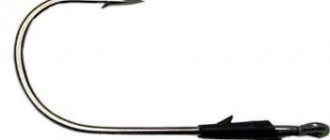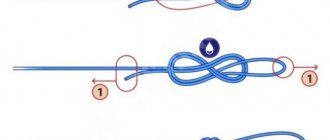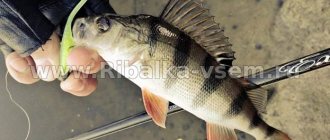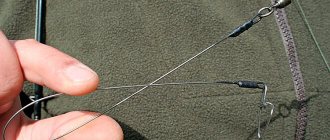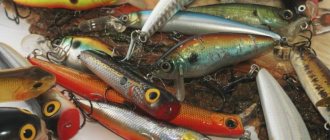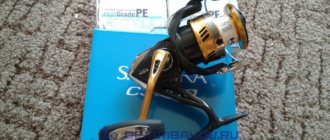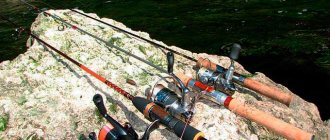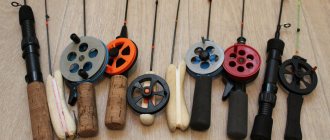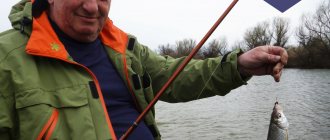Definition and purpose
Fishing hooks are used to hook caught fish and hold them when fishing. In baited gear, they also serve as the basis for attaching natural (animal or plant) or artificial (fly, rubber, foam) bait.
Let's see how a fishing hook can serve in different types of gear:
- Donks and floats involve the use of the simplest fishing hooks that are familiar to most. They are tied at the ends of leashes and equipped with baits for peaceful fish.
- Live bait gear is distinguished by the fact that, in addition to singles, they also use doubles and tees, which are equipped with fish.
- Numerous spinning baits are also equipped with tees: wobblers, spinners.
- In the installation of silicone rubber there is often an offset hook, which provides the equipment with non-snaking quality when placing the bait.
- In fly fishing, a fly is formed on the basis of a hook - an artificial decoy that imitates an insect.
In this fly the hook is almost invisible, although all installation is made on its basis.
On a note! Some baits can be equipped with several hooks, for example, wobblers. And in balancers they are presented in two types: soldered singles and suspended triples.
History of fish hooks
In equipment for amateur and sport fishing, the hook, like the fishing line, plays the most important role.
If you can do without the other elements, then you can’t do without these two. The hook detects and holds the fish, and it also carries the bait, and in some cases serves as it. Having a hook and a strong thread in your arsenal, you can already catch fish, even if not the kind you would like, but suitable for satisfying your hunger in the wild. It was in this primitive way, using wooden hooks, that ancient people caught fish back in the Paleolithic era.
Archaeological finds confirm that fishing, which appeared somewhat later than gathering and hunting wild animals, occupied a very important place in the life of primitive people and existed long before the advent of agriculture.
The oldest fishing devices found in Japan, similar to modern fishing hooks, are no less than 22.5 thousand years old. The age of the artifacts is determined by radiometric dating, so there can be no doubt that people have been able to fish with hooks since prehistoric times.
Components
Every angler should know what parts the subject of our conversation today consists of. To help, we present a photo, below which we provide a description.
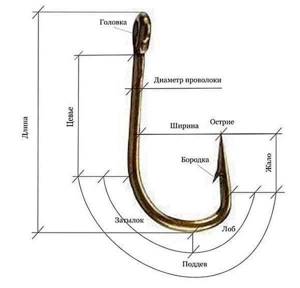
The main parts and parameters of a fishing hook.
Components:
- The head is the place where the hook is attached to the rest of the equipment. Most often it is made in the form of a round or oval ring. Less popular are spatulas.
- Forend – the straight part of the hook from the head to the hook. The length of the forend determines the type of bait used.
- The hook is the curve from the forearm to the sting. In turn, it is conventionally divided into the back of the head and the forehead: the back and front parts, respectively.
- The sting has two sides. On its inner side there is a barb that serves to hold the bait and counteract the fish’s attempts to free itself. The tip of the hook is crowned with the sting.
Attention! Nowadays, good manufacturers sharpen their hooks chemically, so their point is very sharp. And mechanical or pressed processing of the tip may also take place.
The presented photo also clearly shows the technical parameters of the hook:
- The diameter of the wire;
- width - the distance between the forearm and the sting;
- length - from the edge of the head to the top of the undercut.
Classification and selection
To determine which hooks are best suited for your gear and not make a mistake in choosing, you need to have a good understanding of their classification.
By number of subdevs
Depending on the number of hooks, hooks are divided into the following categories:
- single;
- double;
- triple.
Doubles are produced in two versions depending on the size of the undercut:
- same size;
- of different sizes.
In the first case, the hook is made by bending one wire in equal proportions. It allows you to conveniently attach live bait through the mouth or mount a foam or silicone bait.
The second option is two hooks welded together: a large and a small one; such products are also called pike-perch hooks. Their main purpose is to plant fry for live bait fishing rods.
Separately, it is necessary to say about offset printers. These are products with one hook, but with a special forearm shape, designed for mounting silicone jig baits.

Different types of hooks have different purposes.
Special types
And we also need to mention the hooks, equipped with a wire spring designed to hold soft baits. With this addition, an ordinary single bowl turns into a mini-feeder, which is filled with dough, semolina and other similar attachments.
The second unusual hook can be called a non-hooking hook. In this case, a thin wire leading to the tip is soldered to the head. In a double and a tee, the number of such peculiar mustaches corresponds to the number of hooks.
By shape
Different fishing conditions dictate their own rules for the use of hooks of various shapes. The best of them are presented in the following photo.
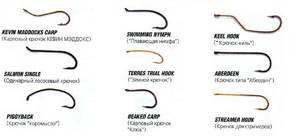
Hooks also differ in the location of the sting relative to the center line. In some cases it is slightly bent from the vertical axis. And there are also models with beards on the fore-end. They are mainly used when it is necessary to bait a worm to prevent it from slipping.
By wire thickness
Everything is very simple here, the thickness depends on the resistance power of the intended trophy and the tenderness of the bait. For example, the thinnest ones are used in winter fishing to bait bloodworms; from a thick hook it will simply flow out.
Attention! More substantial hooks in terms of thickness are used for carp, carp, and catfish.
Finish and color
How to use offset hook with weight
The next difference between the hooks is the outer coating. It is used for two purposes:
- protecting the product from corrosion;
- camouflage equipment under water.
Protect metal in the following ways:
- bronzing;
- nickel plating;
- tin servicing.
Coating colors are designated by the following English abbreviations:
- BK - black;
- BN - black nickel;
- BZ - bronze;
- GO - gold;
- NI - stainless steel;
- PS – red or pewter.
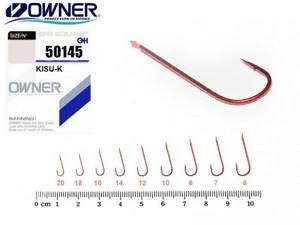
Red color is good for baiting a worm or bloodworm.
Dimensions
Most often, anglers discuss the size of fishing hooks. And it’s not surprising, because the overall success of fishing often depends on the number. It is usually recommended to make a compromise between sufficiency and miniaturization of size.
The sizes depend on two factors:
- the size of the mouth of the proposed trophy;
- volume of nozzle used.
Moreover, the second factor, as practice shows, is sometimes much more important. Agree, it is impossible to bait a bloodworm on a large hook, and a grasshopper on a small one.
Hooks are classified differently depending on the region. Our country has adopted the so-called domestic numbering; there are also international, Japanese, and Finnish ones.
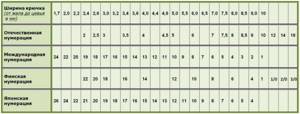
Comparison table of hook numbering.
It is worth noting that Russian numbering is the most understandable. Our hook number corresponds to the width in millimeters. Look at the table, how can you find out what size No. 19 is in the international classification? And according to us, this is 2 millimeters - simple and clear.
Why this happened is explained by competition among manufacturers, who, by the way, often have identical numbers that do not match in size. And if we take our Chinese comrades, the picture will be even more beautiful; some try to adhere to the international numbering, others to the Japanese, and others to the Russian numbering.
Advice! When choosing a hook in a store, look less at its number and evaluate the product by its actual size.
Here is an approximate ratio of sizes and baits used, we present them according to the increasingly popular international classification:
- Nos. 28–24 – designed for the smallest baits: bloodworms, burdock moth larvae, small pellets of bread or dough.
- Nos. 12–16 – the optimal baits here are cereal grains, maggots, and medium-sized pellets of bread.
- Nos. 8–10 – sandwiches made from baits, large lumps of bread, a bunch of maggots, boilies, pellets.
- Nos. 6–7 – worms and their combination with maggots, snails, caterpillars, grasshoppers.
- Larger numbers are considered catfish or belong to offset baits on which silicone or foam rubber baits are mounted.
What are the classifications of hooks?
One of the primary selection criteria is the size of the fishing hook. It is this parameter of the product that plays an important role in catching fish of a certain size. The selected size of the accessory should allow you to securely attach the required volume of bait, which the fish can swallow without much effort. Many fishermen are surprised by the fact that on the store counter he notices a product designated by the same number, but visually differing in dimensions several times.
This is precisely the case when the hook numbers are designated according to classifications that differ radically in the methodology for determining the size. It just so happens that today we most often come across several main types of markings, the nuances of their formation will be discussed in our further and more detailed discussion.
Domestic

Our domestic classification of hooks is logical and easy to understand. Without any kind of unnecessary calculations and guesswork, using just the numerical value of the accessory, you can easily figure out the size of the hook. In addition, the numbering scale is built on an ascending principle: the higher the number, the larger the product, which is more understandable when selecting the right option for fishing conditions. The numerical value according to the domestic classification method is assigned based on the distance measured from the forearm to the sting, and this, simply put, is the usual width of the hook.
Important! The model range in the domestic line of accessories begins with the numerical value 2 and ends with the largest number, and therefore the product numbered 16.
To determine the hook number, a simple measurement is enough. But it is worth noting that this technique is not popular in the international fishing sphere and its application is mainly used in our country and neighboring countries of the post-Soviet space.
International

Most European and American well-known brands producing fishing hooks operate according to the international classification. To be fair, we add that the so-called international numbering system is actually a purely English method for calculating sizes, often called the Reddish scale. The system received this name from the British city of Redditch, where a famous factory for the production of fishing accessories was located. The classification developed by the plant's management has taken root in the fishing industry, becoming the world's main system for designating the size range of a fishing hook. The classification of fishing hooks on the international scale is radically different from the domestic system.
Important! In the international classification, the largest numerical value corresponds to the size of the smallest hook.
The line of sizes itself fits into the numerical range from 24 to 1. As a result of design changes in the accessory and the need for the production of larger products, the numbering has undergone changes and hooks whose dimensions exceed the classic original limit, most often this applies to offset workers, are designated by a double number according to the presented further example - 2/0. There is no logical explanation for the reverse numbering and you simply have to remember it, sometimes comparing it with a more understandable domestic size classification scale.
Japanese
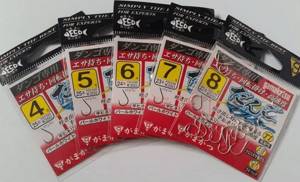
Japanese manufacturers present the product according to their own classification scale. Without further ado and without bothering to invent a diagram, they adopted as a basis the principle of calculating size according to the international system, with the difference that the Japanese size range was shifted upward by two points. Thus, it turns out that the tenth hook size on the international scale corresponds to the size of the twelfth number according to the Japanese classification, and the English twentieth corresponds to the twenty-second Japanese number. Based on this fact, when purchasing fishing hooks, you should definitely pay attention to the country of origin of the product and only after that analyze the sizes of fishing hooks by numbering corresponding to the origin of the product.
Finnish
The Finnish system makes it even more difficult to determine the appropriate numerical value. In some ways, the Finnish version of numbering is similar to the Japanese scale, but it has a number of important differences that the fisherman needs to know when choosing the optimal size product. This classification lacks a number of dimensions inherent in other systems, and the bottom of the assembled table, where the largest hooks are assigned, is designated by two numbers, like the modern superstructure of the international system.
In addition to these nuances, fishing hooks numbers 14, 16, 18 and 22 coincide with Japanese accessories, taking into account the decrease in their value by one. It cannot be denied that there is a certain complexity in comparing products in this area, but with accumulated knowledge and updating of various systems, literacy and accuracy in selecting the right hook can be achieved by the fisherman, regardless of the country of manufacture.
Manufacturers
The undisputed leaders in the production of hooks are Japanese, American and Finnish companies. As for individual brands, the following stand out:
- Owner – the best hooks for catching carp fish;
- Mustad – tees for deep and winter predator fishing;
- Gamakatsu are leaders in the choice of sports anglers;
- Korum - products are distinguished by the most careful treatment of fish;
- Saikyo are the most affordable hooks in terms of price.
You shouldn’t discount Chinese manufacturers, whose products are becoming better every year, while remaining the most inexpensive in cost.
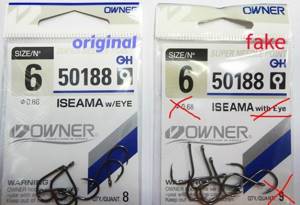
When choosing a hook from a well-known company, do not fall for a fake. The main differences between fake products can be seen in the comparative photo.
As can be seen from the list of leading brands, Japanese companies are the leaders in production. It is the hooks from the Land of the Rising Sun that are used by professional fishermen and athletes at the most important fishing competitions.
Review of some models on the modern fishing tackle market
We can say that circle hooks with a self-cutting tip are universal. Among those available on the market, you can choose the best option for use both with natural baits and lures, and for fishing with artificial baits, such as silicone or spinners, and success is obvious even when fishing on the “track” (tension is created by the mass of the spinner).
Among the options available on the European market, there are three main manufacturers of self-cutting fishing hooks, among which the angler must definitely find the type and model that fully satisfies his needs.
- Rapala VMC Corporation. As a striking example of the described type of hooks, we can cite the VMC MYSTIC® MATCH Pellet Feeder model. These are single, reinforced hooks, produced under numbers 10, 12, 14 and 16, aimed at feeder and match fishing. The unsurpassed sharpness of the sting ensures instant hooking of fish. It has a high quality coating and is focused on the use of baits of plant and animal origin. The price for a package of 10 pieces is very affordable and is about 190 rubles.
- Gamakatsu Fishing Hooks. A Japanese brand, among whose models a prominent representative is the single hook Gamakatsu LS-3513F. This series is aimed at catching carp fish and is made of high-quality steel with the use of chemical sharpening of the tip. Like most hooks of this type, the axis of the hook is directed towards the attachment point. This ensures instant and reliable hooking of the fish, while causing minimal injury to it. One of the indicators of the quality of this company's products is that many European bait manufacturers use Gamakatsu hooks. The LS-3513F model comes in a package of 13 pieces, the cost of which is about 130 rubles.
- Eagle Claw. Hooks made in the USA, the name of which speaks for itself and translates as “eagle claw”. A traditional representative of the non-classical type of self-cutting hooks. The manufacturer offers many options for both single and double hooks. However, they are all united by reliability, American quality workmanship, as well as versatility in relation to catching various types of fish. However, the price corresponds to the positioning. Thus, the Eagle Claw L2004G model in a package of 5 pieces will cost about 400 rubles, and you can’t buy it in all Russian stores.
We recommend reading: Characteristics of spinning reels, tips for choosing them
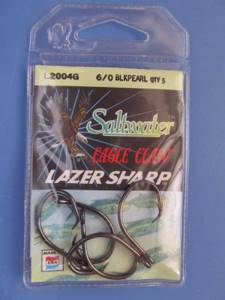
Practical recommendations for choosing
To choose the optimal hook and successfully catch exactly the fish for which it is intended, we will give several recommendations:
- choose products from manufacturers you know;
- try, if possible, to minimize the hook to the size of the bait;
- for fishing in sea water, use hooks protected from active substances;
- try to choose camouflage colors, for example, a red hook for bloodworms, a black hook for fishing on a dark muddy bottom, etc.;
- keep an eye on the sharpness of the hook, change it after particularly active fishing or sharpen it with a small file or sandpaper;
- store hooks in the bags in which they are sold in the store, and never in bulk in jars;
- on an equipped fishing rod, stick the tip into specially fixed pieces of foam rubber or similar soft material.
Features of choice for some conditions
For winter
Winter hooks are characterized by greater minimization compared to summer fishing. This applies to both the size and thickness of the wire from which they are made. In addition, it is recommended to equip winter gear with hooks whose shank length is one and a half times greater than its width. This is necessary to make it convenient in the cold to bait such a delicate creature as bloodworms, which is the number one bait in winter fishing.
For roaches in summer
Hooks for catching roach in summer are used no larger than number eight according to the international classification; larger sizes are considered carp. And even then, this value is only suitable for worm bait. For baiting with maggot, pearl barley or corn, it is optimal to equip fishing rods with hooks of 14–18 numbers.
The most common shapes of hooks
Round hooks. Their bow is almost semicircular. The most famous and popular is the “perfect” type with a short, medium and long forearm and a bent or straight point. The forend ends with a spatula, but there are also options with a ring bent inward (it is better to tie a metal leash). For catching carp, the “perfect” hook is very suitable, the length of the shank of which is twice as long as the width of the hook; for catching predators - hooks with a long shank with a ring bent inward.
Initial shapes of hooks: a - rounded; b - semi-rounded; c - angular
Semi round hooks. The transition between the forend and the top of the hook is slightly flattened. The most famous type is the “limerick” with a bent tip; these hooks are usually coated with black or dark brown enamel. The “Italian” option is very popular among amateur fishermen. It has a point bent to the side and is dark brown in color. The semicircular hooks also include the famous “crystal”; such hooks are always flat, without a point bent to the side; color - golden or silver. The silver-colored “crystal” is always somewhat narrower. It is indispensable for catching small fish. The group of semicircular hooks also includes hooks for fishing with an artificial fly.
Angled hooks. They have an angular shape. They are used for catching predatory fish, and large hook sizes are popular. Triple hooks can also have an angular shape.
You can also note a group of hooks of special shapes. These include Kirby and Mackenzie Crystal hooks. The latter is a transitional type between round and semi-circular hooks. Due to its flat shape with a relatively short fore-end and massiveness, it is often used for catching carp.
The forend of all types of hooks ends with a head made in the shape of a ring, a spatula, a thin undercut, a ribbed head. The sting has a conical shape and can be bent inwards - towards the fore-end or outwards - from the fore-end.
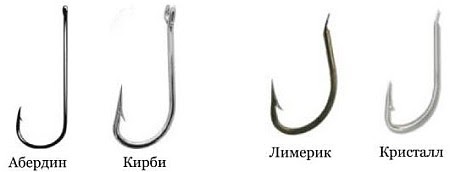
The oldest form of fish hook is considered to be the Aberdeen round shape. In addition to the mentioned form, the Limerick form is also considered the basic one. The common forms Kirby and Crystal are derivatives of the first two.
Every serious fishing brand has a whole series of hooks of various types and shapes with their own names. At the same time, a classification of hooks was made for each method of fishing, peaceful and predatory, sea and freshwater fish, etc.
Hooks can be single (single hook), double (double hook, double), triple (three hook, tee, anchor), as well as single bend and double bend, i.e. curved in two planes. In addition, hooks vary in thickness and shank length.
Single hooks are universal: they are equipped with most amateur fishing gear for fishing with natural baits and artificial baits. Double and triple hooks are used mainly for fishing with live bait and for rigging spoons, Devon and artificial fish.
Hook finish and color
Since the main material for producing hooks is carbon steel, which is not resistant to corrosion, the thinnest layer of non-ferrous metal is applied to such products using the galvanic method. Bronzing is most often used, but does not guarantee 100% protection against oxidation. To further protect the product, it is covered with a polymer paint layer on top, and color is also added. A less common method is nickel plating with added color (from silver to black). Considering the durability and reliability of nickel relative to bronze plating, its cost is an order of magnitude higher. Thanks to the thinnest layer of polymer varnish, which fills the pores of black nickel, the surface of the fishing product is perfect. Another option for protecting the product is tin plating.
Color is an important factor that reduces fish suspicion when biting bait, and therefore must match the color of the bait or the bottom of the reservoir. The color of the hook is determined by the anti-corrosion coating, as already mentioned, it is applied by various methods of surface treatment of metals: chrome plating, oxidation, enameling, tinning, silvering, gilding.
